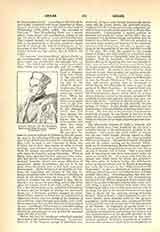

Geissel, JOHANNES VON, Cardinal, Archbishop of Cologne, b. February 5, 1796, at Gimmeldingen, in the Palatinate; d. September 8, 1864, at Cologne. After completing his classical studies at Neustadt-on-the-Hardt, and at Edesheim, he was received into the then imperial Lyceum of Mainz in 1813, and studied theology in the diocesan seminary of the same city, under Prof. Liebermann, from 1815 to 18. He was ordained priest, August 22, 1818. For a short time he became assistant in the parish of Hambach. On February 1, 1819, he was appointed professor at the Gymnasium of Speyer; on June 24, 1822, canon of the cathedral chapter of Speyer; and on May 25, 1836, dean of that body. Nominated Bishop of Speyer by the King of Bavaria, he was preconized by Gregory XVI, May 20, 1837, and consecrated in Augsburg cathedral the following August 13.
The new bishop displayed such zeal and efficiency that after four years he was called to a larger sphere of activity. After the accession to the throne of Prussia of Frederick William IV, the “conflict of Cologne” was to be settled amicably by an agreement between Church and State, to the effect that Archbishop Clemens August von Droste-Vischering would relinquish the personal direction of the archdiocese, which should pass over to a coadjutor with the right of succession. On September 24, 1841, Gregory XVI appointed Geissel coadjutor to the Archbishop of Cologne; and on March 4, 1842, he entered upon the administration of the archdiocese. When Clemens August died (October 19, 1845), Geissel succeeded him, and was enthroned as archbishop, January 11, 1846. Finally, Pius IX created him cardinal, September 30, 1850.
Geissel was a man of many gifts and great energy, one of the foremost German bishops of the nineteenth century. His services in behalf of the Catholic Church in Prussia and throughout Germany are of permanent value. Discretion and a sense of justice on the part of the government of Frederick William IV made it possible for the cardinal to regulate and ameliorate the conditions of the archdiocese in harmony with the policy of the State. He ended the heretical dissensions created by the Hermesian School by suspending the refractory Hermesian professors Braun and Achterfeldt of Bonn; and he reorganized the theological faculty of that university by calling in as professors Dieringer and Martin, men of unsuspected orthodoxy. He was also solicitous for the education of the clergy, and established two seminaries for boys at Neuss and Munstereifel. To instill new zeal into the spiritual life of his people he encouraged popular missions, introduced religious orders and congregations into the archdiocese, instituted the Perpetual Adoration, and stimulated devotion to the Blessed Virgin by celebrating with unusual splendor the declaration of the dogma of the Immaculate Conception. Of still greater importance for the Church in Germany was his convocation of the German episcopate to a meeting at Wurzburg, 1848. The result of this meeting of the hierarchy was a number of momentous deliberations for the future prosperity of the Church. In 1860 he held a provincial council at Cologne. Another matter which the cardinal had at heart during his life, was the completion of Cologne cathedral, the preparations for which had commenced in 1842. Geissel lived long enough to see the edifice completed and dedicated in October, 1863.
In the years preceding his elevation to the episcopal dignity, Geissel also displayed notable literary activity. During the first two decades of its existence (1821-37) he contributed numerous anonymous essays of either serious or humorously-satirical character on questions and occurrences of the day to the “Katholik”, and became one of the foremost contributors to that periodical. His unusual poetical talent is shown by a number of poems, mostly of a religious character, and published partly in that periodical, partly issued singly, as the occasion offered. After his death there appeared a special edition of his “Festgedicht auf die Grundsteinlegung zum Fortbau des Kolner Doms” (Cologne, 1865). However, his most marked effort as a writer is his historical work, “Der Kaiser—Dom zu Speyer. Eine topographisch-historische Monographie” (3 vols., Mainz, 1828); 2nd ed. in one volume, as vol. IV of his “Schriften und Reden” (Cologne, 1876).
Other historical writings of less significance are: “Der Kirchensprengel des alten Bisthums Speyer” (Speyer, 1832); “Die Schlacht am Hasenbuhl and das Konigskreuz zu Gollheim” (Speyer, 1835). Of other separate writings are to be mentioned “Sammlung aller Gesetze und Verordnungen; Aber das Kirchen- und Schulwesen im bayerischen Rheinkreise vom Jahre 1796-1830” (Speyer, 1830); “Die religiose Erziehung der Kinder aus gemischten Ehen. Eine geschichtlichen-rechtliche Erorterung” (Speyer, 1837); first published in the “Katholik” vols. LXIII-LXIV, (1837). His pastoral letters, memoirs and addresses composed by him during his episcopacy, show a great mind and heart. They have been collected with other dispersed and minor writings of earlier days, and various poems, in “Schriften und Reden von Johannes Cardinal von Geissel, Erzbischof von Koln, herausgegeben von Karl Theodor Dumont” (Vols. I-III, Cologne, 1869-70); later on vol. IV was added, “Der Kaiserdom zu Speyer”, 2nd ed. (1876).
FRIEDRICH LAUCHERT

